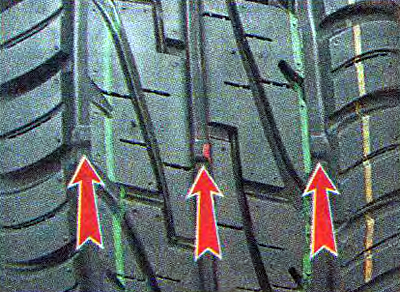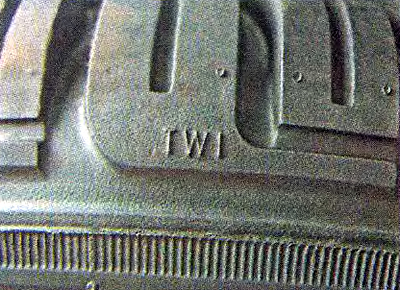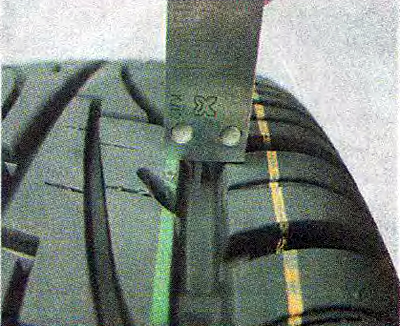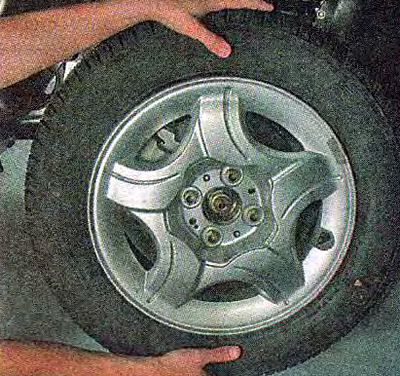Execution sequence
1. Before each trip, we carefully inspect the wheels of the car and their fastening elements. Each wheel is attached to the hub with four bolts. We vigorously press the sidewall of the wheel with our foot, swinging it in the transverse direction. If the wheel bolts are not tightened, it will begin to dangle on the hub. At the slightest suspicion of a loosening of the wheel fastening, we check the tightening of the bolts (tightening torque is specified in section «Reference data», see p. 108). Wheel rims must be free of cracks and signs of deformation. Tires must not have cuts, delaminations, ruptures, bulges («hernia»), protrusions of the cord.
2. In the absence of mechanical damage to the tire, its suitability for operation is determined by the height of the tread pattern.
Visually determine the height of the tread by the indicator protrusions in the grooves of the pattern.

The protrusions are 1.6 mm high. As soon as the tread height is equal to the height of the ledge, the tire must be replaced.
The indicators are located around the entire circumference of the tire at some distance from each other. We find them by symbols in the form of letters «TWI» or shooters «A» on the sidewall of the tire.

3. We determine the exact height of the tread using a caliper depth gauge and compare the degree of tire wear at the edges and in the middle. Accelerated wear of the middle part of the tread indicates the operation of the tire with increased pressure, along the edges of the tire - with reduced pressure, and rapid wear of the inner or outer part of the tread indicates the need to adjust the wheel alignment. Intensive wear of one of the wheels may be caused by deformation of the suspension elements or the power elements of the car body.

Warning! According to «Appendix to the Basic Provisions on the admission of vehicles to operation and the duties of officials to ensure road safety», the operation of a passenger car is prohibited:
- - if the tire tread height is less than 1.6 mm;
- - with tires that have external damage (breaks, cuts, breaks), exposing the cord, as well as carcass delamination, tread and sidewall delamination;
- - if there is no mounting bolt or there are cracks in the disk and wheel rims, there are visible violations of the shape and size of the mounting holes;
- - if the tires do not match the model of the vehicle in terms of size or load capacity;
- - if tires of different sizes, designs are installed on one axle of the car (radial, diagonal, chamber, tubeless), models with different tread patterns, studded and non-studded, frost-resistant and non-frost-resistant, new and restored.
4. The appearance of vibration felt on the body or steering wheel when the car is moving at a constant speed over 80 km / h may be due to an imbalance of one of the wheels. To identify the cause, we check the wheel balance in a tire shop. If the vibration is caused by disk deformation, tire damage or uneven wear, replace the tire or disk.
5. Alternately hang each wheel of the car (see «Preparing the car for maintenance and repair») and swing it in a vertical plane.

In hubs with worn bearings, play will be felt. To make sure that the play is not caused by faulty suspension parts, repeat the test with the brake pedal depressed. If the knock disappears, then the hub bearing is faulty.
Replace defective bearings (see «Front wheel bearing - replacement» And «Rear wheel bearing - replacement»). If a knock is heard, check the condition of the suspension (see «Checking the technical condition of the front suspension» And «Checking the technical condition of the rear suspension»).
